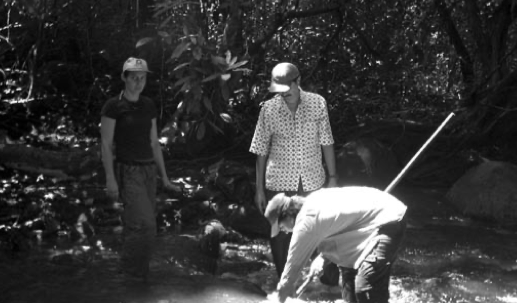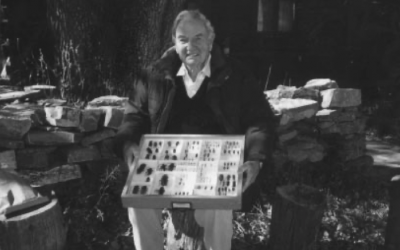El Tesoro de Volcán
Water-based community organizing in Costa Rica
Carlos Beita and his cousin Alfonso, rugged-looking ranchers both, squat beside biologist Ruth Tiffer as she explains how to take samples from a stream bed. Scooping a rock from the current, she points out the metropolis of algae and water insects that flourishes on its surface. The cousins pick off the critters with tweezers and store them in a vial of alcohol.
Somewhat bemused, I stand off to the side with my pen and notebook. I was invited to the town of Volcán, in southern Costa Rica, to learn about the efforts of the community to preserve their watershed; the early morning lesson in ecology is somewhat unexpected. The rest of the group—numbering seven, a mix of locals and visiting conservationists—ventures out enthusiastically into the river, nets, vials and tweezers in hand.
“The people of Volcán need to be able to monitor their own watershed,” explains Ruth, who runs an environmental consulting firm in the capital. “They have detailed first-hand knowledge of what’s been happening to the river, but no data to back it up. Scientific information helps to tell the river’s story.”
Carlos Beita, casting a net by a sunny pool, says that whereas the current once carried large fish and otters, there now only insects and polliwogs. The river is not quite dead, but a shadow of its former self.
Anecdotal evidence that the Río Volcán has been losing its vitality echo local stories readily heard across Latin America of shrinking lakes and dwindling rivers. As in most tropical countries, urbanization, intensive agriculture and deforestation in Costa Rica, are putting stress on what was once seen as a limitless commodity. Even the lush southern region, with an average 13 feet of rainfall yearly, faces the specter of contamination and water scarcity.
That nature has an intrinsic productive value, for instance the oxygen emitted by a forest or the water filtered by a marsh, is by now a trope of the sustainable development school of thought. In Volcán, the embryonic group Amigos del Río Volcánrecognizes that preserving the river’s integrity is vital to the well-being of local communities. Today’s excursion reflects a strategy for charting their vision of the river’s value, beginning with a description of its sources, seasonal fluctuations and aquatic life.
Less than ten miles from Volcán, the vast, largely unexplored expanses of the Amistad-Talmanca conservation area provide a natural production plant for water. Filtering through cloud forests of fantastic biodiversity, rainwater courses down the Talamanca massif in streams and small rivers (including the Río Volcán,) merges in the wide Valle del General and meanders through swampland out to the Pacific.
These lands are ideal for the cultivation of pineapple, which requires both abundant water and steady tropical sunshine. The Pineapple Development Corporation (Pindeco,) a subsidiary of the Del Monte fruit company, has operated in the Valle del Generalsince 1978. One of the most successful cases of the 1980’s “alternative export” strategy, pineapple now ranks fourth among Costa Rica’s exports. Pindeco is the most important producer of pineapple in the country, and unquestionably the economic engine of the zona sur.
After clambering out of the river, we drive out to the plains that belong to Pindeco. Rows of stiff pineapple plants stretch off to the horizon; their spiky, knee high sameness gives the landscape the look of a giant buzz-cut. Besides the shadow of a passing vulture, the acres are eerily still; not an insect, not a bird makes a sound.
Until recently, the impact of pineapple cultivation on local ecosystems faced a tacit code of silence. In the late nineties, concerns about the effects of chemicals on worker health and the environment crystallized in a citizens’ action group, the “United Front Against Pindeco Pollution.” Drawing nearly a hundred people from across the southern region, the Front eventually crumbled as members fearing for their jobs withdrew support. (Pindeco’s San José office was unable to comment after a week’s worth of phone calls for this article.)
In 1998, Pindeco obtained ISO 14001 certification in environmental management and has since made important reforms in its planting policies. Nonetheless, members of the Amigos continue to notice the damage caused by chemical runoff, extensive irrigation from the river during the dry season, and especially pineapple plantings in the highlands. It is not enough, I hear repeatedly throughout the day, for the company to adopt internal environmental standards; we need to have a say in the decisions that are going to affect the river.
Drawing lessons from the experiences of the Front, the Amigos del Río de Volcán focus their energies, not on confronting the company, but primarily on strengthening and uniting local communities. Marielos Solís, a young architect with family roots in the area, often spends her weekends making the four hour trek from the capital to Volcán, where she has been working as an ad hoc community organizer for more than a year.
“The challenge in this town,” she says, “is to create a sense of will and self-reliance. People are so dependent on Pindeco; 90 percent of the town is employed by the company. We have to educate so that the people feel an ownership of the river, which is after all the real treasure of Volcán.”
In the late afternoon, the group visits a tributary of the Volcán in the hills that border Amistad national park. Splashing down mossy cliffs into a frothing, dangerous whirlpool, the waterfall is hypnotic to behold. However, Alfonso, Ruth and conservationist Johnny Rosales are most interested in the hills beyond, which have been completely denuded by cattle grazing. An animated discussion ensues on how to educate local farmers and ranchers on watershed protection. Perhaps Pindeco will donate seedlings for reforestation, Alfonso ventures; perhaps this opens up an opportunity for dialogue with the company, Johnny adds.
Back in town, the group stays up late discussing their next steps. As they joke and debate, the complexity of their situation becomes clear; seeking a more rational and democratic management of the river will draw the Amigos into the orbit of government ministries, transnational corporations and international NGOs. Negotiating the interests of these entities, while maintaining the support of the community, is a daunting task; but a certain stubborn love for the river, transcending its quantifiable value, seems sure to sustain them.
Fall 2004/Winter 2005, Volume III, Number 1
Lindsey McCormack graduated from Harvard College in 2003 with a degree in History and Literature and a Latin American Studies certificate from DRCLAS. She currently works as a speechwriter at the Arias Foundation for Peace and Human Progress in San José. Amigos del Río Volcán is looking for student volunteers. Contact: Marielos Solis <djsolis@rasca.co.cr>.
Related Articles
The Natural World
In the late spring of 1934, towards the end of my sophomore year at Harvard College, I received a letter from Dr. Frank E. Lutz, Entomology Curator at the American Museum of Natural History in…
Disappeared: A Journalist Silenced
The cover of Disappeared: A Journalist Silenced depicts the Guatemalan journalist Irma Flaquer holding up a page in her left hand as if proofreading. Yet, her eyes are not looking at the paper…
Kenneth Maxwell at DRCLAS
As the new coordinator of Brazilian Studies at the David Rockefeller Center, it is a treat for me to write a few words on Kenneth Maxwell’s arrival to DRCLAS, where he is now a Senior Fellow. To…





